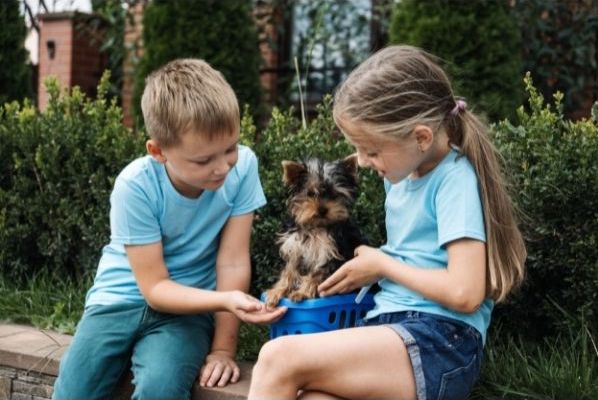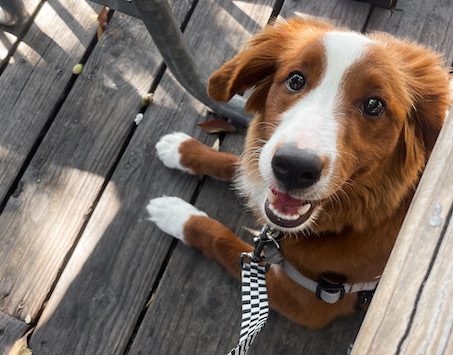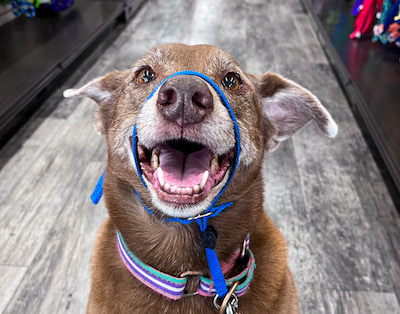Bringing your new puppy home to your children can be the most exciting time! Growing up with a dog can help teach patience, how to care for an animal and responsibility – but it can also be a little overwhelming. We have put together some age-appropriate ways your kids can contribute to your new puppy’s training and welcome your new furry family member into your home!
Including kids in puppy training
Teaching your child how to treat your puppy is vital to encourage a positive relationship between your puppy and your child. Making sure that they are calm and gentle with him will teach your puppy to be calm and gentle while also setting them up to approach all dogs in a safe way. Learning how to respect your puppy’s boundaries and how to read their body language can benefit your child long-term.
It’s tempting to wrestle or rough house with your puppy but this can easily lead to and reinforce problem behaviors like play-biting and jumping. Instead, have your child pet your puppy on the neck and chest (not the head) and praise them. You can also give your puppy a treat whenever they are exhibiting calm behaviors around your kids like laying down or sitting. Puppies and kids both can get overwhelmed during playtime, which can lead to undesirable interactions. Puppies tend to play with children the way they would play with other puppies, but humans don’t have a fur coat to protect against playful puppy claws and teeth. Make sure that every interaction your child and puppy have is a positive one, which starts with reinforcing calm behaviors.
For some more examples of common puppy behaviors, check out our CFO Sean Savage in our vlog designed to help you navigate puppyhood!

Hand Feeding (ages 5+)
Mealtimes are a great time to get some training in for both your puppy and your kids! Instead of giving the bowl of food to your puppy, have your kids hand-feed him. This will teach your puppy how to take food nicely from their hands and also strengthen the bond between your puppy and child. For more information about hand feeding and other ways to feed your puppy, check out our blog post “Feeding Your Puppy: How to Utilize Mealtimes”
- Under adult supervision, have your child feed the puppy handfuls of kibble.
- You can increase the difficulty for the puppy by waiting for them to sit before giving them the food.
- Please don’t ask your puppy to sit, instead, wait for them to sit or lure the puppy into the sit position.
Trainer Tip: If your child is a little scared or wary of your new puppy, it is important to make sure that every interaction is a happy one. If your puppy jumps or play-bites your kids, you can hold on to their leash so that they cannot jump and have your kids drop their kibble when they are sitting nicely and work their way up to hand feeding when they are comfortable.
Name Recognition (ages 9+)
Using name recognition as a game with your puppy is a wonderful way to involve your kids in training! The goal of name recognition is that your puppy will not only look at you when you say their name but also come to you. Starting early and staying consistent will strengthen this skill over time.
We recommend starting this game without the kids initially to “teach” your puppy the rules of the game first.
- Start off with a handful of kibble. Standing in front of your puppy, say their name once and as soon as they look at you, use the bridge word “good” and give them one piece of kibble.
- Practice this in a few different rooms of the house.
Trainer Tip: It is crucial to only say your puppy’s name once for each repetition during training. Saying it multiple times diminishes the power of the name and allows them to ignore the first few times you say it and only come to you when they decide to. If your puppy is struggling, try more verbal encouragement after they look at you (“good job!” Kissy noises, or clapping), or get a little closer. Then, after a few good reps, make sure you end on a positive note and take a break. - Then, increase the difficulty by standing a few feet away. After you say their name, lure them closer to you by holding the food out to them and slowly drawing your hand to your body, your puppy should move with your hand to you.
- As soon as they get to you, give them the food, and then back up a few feet and do it again. Puppies do best with fast repetitions and lots of encouragement in the beginning.
- Once your puppy is happily coming to you when you say their name, have your kids play the game with your puppy.
- If your puppy is reliably coming when you say their name increase the difficulty by hiding in the house, saying their name, and rewarding them generously when they come to you!
Avoid saying your puppy’s name randomly throughout the day without a reward or only saying their name when they are in trouble. Doing these things can cause your puppy to be less attentive to their name and can sometimes create a negative association with their name. It is vital that their name is paired with good things so that they come to you when you say it!
If you would like some more ways to involve your children in training or ideas and exercises to help your kids and puppy bond, please reach out! We would love to help put together a plan that best fits your training goals. Puppy consultations and full puppy training programs can both be customized to integrate your children into the training process. Contact us for more information!




